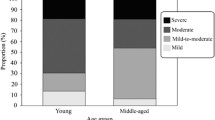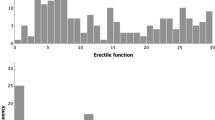Abstract
Erectile dysfunction (ED) is associated with complex psychological and interpersonal issues. A new measure of treatment outcome, the Psychological and Interpersonal Relationship Scales (PAIRS), was developed to evaluate the broader psychological and interpersonal outcomes associated with erectile dysfunction and its treatment. Initial items were generated based on literature review, focus groups and market research, interviews with patients and partners, and consultation with expert clinicians. Domains of Sexual Self-Confidence, Spontaneity, and Time Concerns were identified and subsequently confirmed by factor analysis. A series of validation studies was performed with four separate samples, including assessment of internal consistency and test-retest reliability, convergent and discriminant validity, and treatment responsiveness. Samples for these studies included men recruited from clinical trials for ED in several countries (N =413) and a community sample (N =801). Findings from these studies indicate that PAIRS demonstrates adequate psychometric properties and appears well suited for use in further clinical studies of treatments for ED. It provides a broader assessment of treatment outcome than current measures of erectile function.
Similar content being viewed by others
REFERENCES
Althof, S. E. (2002a). Quality of life and erectile dysfunction. Urology, 59 803–810.
Althof, S. E. (2002b). When an erection alone is not enough: Biopsychosocial obstacles to lovemaking. International Journal of Impotence Research, 14(Suppl. 1), 99–104.
Althof, S. E., Corty, E. W., Levine, S. B., Levine, F., Burnett, A. L., McVary, K., et al. (1999). EDITS: Development of questionnaires for evaluating satisfaction with treatments for erectile dysfunction. Urology, 53 793–799.
Araujo, A. B., Durante, R., Feldman, H. A., Goldstein, I., & McKinlay, J. B. (1998). The relationship between depressive symptoms and male erectile dysfunction: Cross-sectional results from the Massachusetts Male Aging Study. Psychosomatic Medicine, 60 458–465.
Bandura, A. (1986). Social foundations of thought and action: A social cognitive theory. Englewood Cliffs, NJ: Prentice-Hall.
Bandura, A. (1994). Self-efficacy. In V. S. Ramachaudran (Ed.), Encyclopedia of human behavior (Vol. 4, pp. 71–81). New York: Academic Press.
Bandura, A. (1997). Self-efficacy: The exercise of control. New York: Freeman.
Brock, G. B., McMahon, C. G., Chen, K. K., Costigan, T., Shen, W., Watkins, V., et al. (2002). Efficacy and safety of tadalafil for the treatment of erectile dysfunction: Results of integrated analyses. Journal of Urology, 168 1332–1336.
Brookes, S. T., Donovan, J. L., Peters, T. J., Abrams, P., & Neal, D. E. (2002). Sexual dysfunction in men after treatment for lower urinary tract symptoms: Evidence from randomized controlled trial. BMJ, 324 1059–1061.
Cappelleri, J. C., Rosen, R. C., Smith, M. D., Mishra, A., & Osterloh, I. H. (1999). Diagnostic evaluation of the erectile function domain of the International Index of Erectile Function. Urology, 54 346–351.
Cohen, J. (1988). Statistical power analysis for the behavioral sciences (2nd ed.). Hillsdale, NJ: Erlbaum.
Feldman, H. A., Goldstein, I., Hatzichristou, D. G., Krane, R. J., & McKinley, J. B. (1994). Impotence and its medical and psychosocial correlates: Results of the Massachusetts Male Aging Study. Journal of Urology, 151 54–61.
Fichten, C. S., Spector, I., Amsel, R., Creti, L., Brender, W., & Libman, E. (1998). Sexual Self-Efficacy Scale-Erectile Functioning. In C. M. Davis, W. L. Yarber, R. Bauserman, G. Schreer, & S. L. Davis (Eds.), Handbook of sexuality-related measures (pp. 534–537). Thousand Oaks, CA: Sage.
Gagnon, J. H., Rosen, R. C., & Leiblum, S. R. (1982). Cognitive and social aspects of sexual dysfunction: Cognitive scripts in sex therapy. Journal of Sex and Marital Therapy, 8 44–56.
Goldstein, I., Lue, T. F., Padma-Nathan, H., Rosen, R. C., Steers, W. D., & Wicker, P. A. (1998). Oral sildenafil in the treatment of erectile dysfunction. New England Journal of Medicine, 338 1397–1404.
Hays, R. D., & Hadorn, D. (1992). Responsiveness to change: An aspect of validity, not a separate dimension. Quality of Life Research, 2 73–76.
Hendrick, S. (1988). A generic measure of relationship satisfaction. Journal of Marriage and the Family, 50 93–98.
Hendrick, S. S., Dicke, A., & Hendrick, C. (1998). The Relationship Assessment Scale. Journal of Social and Personal Relationships, 15 137–142.
Latini, D. M., Penson, D. F., Colwell, H. H., Lubeck, D. P., Mehta, S. S., Henning, J. M., et al. (2002). Psychological impact of erectile dysfunction: Validation of a new health related quality of life measure for patients with erectile dysfunction. Journal of Urology, 168 2086–2091.
Latini, D. M., Penson, D. F., Lubeck, D. P., Wallace, K. L., Henning, J. M., & Lue, T. F. (2003). Longitudinal differences in disease specific quality of life in men with erectile dysfunction: Results from the exploratory comprehensive evaluation of erectile dysfunction study. Journal of Urology, 169 1437–1442.
Laumann, E. O., Gagnon, J. H., Michael, R. T., & Michaels, S. (1994). The social organization of sexuality: Sexual practices in the United States. Chicago: University of Chicago Press.
Laumann, E. O., Paik, A., & Rosen, R. C. (1999). Sexual dysfunction in the United States: Prevalence and predictors. JAMA, 281 537–544.
Leiblum, S. R. (2002). After sildenafil: Bridging the gap between pharmacologic treatment and satisfying sexual relationships. Journal of Clinical Psychiatry, 63(Suppl. 5); 17–22.
Leiblum, S. R., & Rosen, R. C. (1992). Couples therapy for erectile disorders: Observations, obstacles and outcomes. In R. C. Rosen & S. R. Leiblum (Eds.), Erectile disorders: Assessment and treatment (pp. 226–254). New York: Guilford.
Litwin, M. S., Nied, R. J., & Dhanani, N. (1998). Health-related quality of life in men with erectile dysfunction. Journal of General Internal Medicine, 13 159–166.
MacDonagh, R., Ewings, P., & Porter, T. (2002). The effect of erectile dysfunction on quality of life: Psychometric testing of a new quality of life measure for patients with erectile dysfunction. Journal of Urology, 167 212–217.
McKinley, J. B. (2000). The worldwide prevalence and epidemiology of erectile dysfunction. International Journal of Impotence Research, 12(Suppl. 4), 6–11.
NIH Consensus Development Panel on Impotence. (1993). Impotence. JAMA, 270 83–90.
Porst, H., Padma-Nathan, H., Guiliano, F., Anglin, G., Varanese, L., & Rosen, R. (2003). Efficacy of tadalafil for the treatment of erectile dysfunction at 24 and 36 hours after dosing: A randomized controlled trial. Urology, 62 121–125.
Rosen, R. C. (1998). Quality of life assessment in sexual dysfunction trials. International Journal of Impotence Research, 10(Suppl. 2), 21–23.
Rosen, R. C., Cappelleri, J. C., & Gendrano, N. (2002). The International Index of Erectile Function (IIEF): A state-of-the-science review. International Journal of Impotence Research, 14 226–244.
Rosen, R. C., Riley, A., Wagner, G., Osterloh, I. H., Kirkpatrick, J., & Mishra, A. (1997). The International Index of Erectile Function (IIEF): A multidimensional scale for assessment of erectile dysfunction. Urology, 49 822–830.
Rosenberg, M. (1965). Society and the adolescent self-image. Princeton, NJ: Princeton University Press.
Shabsigh, R., Klein, L. T., Seidman, S., Kaplan, S. A., Lehrhoff, B. J., & Ritter, J. S. (1998). Increased incidence of depressive symptoms in men with erectile dysfunction. Urology, 52 848–852.
Snell, W. E., Jr. (1998). The multidimensional sexual self-concept questionnaire. In C. M. Davis, W. L. Yarber, R. Bauserman, G. Schreer, & S. L. Davis (Eds.), Handbook of sexuality-related measures (pp. 521–524). Thousand Oaks, CA: Sage.
Sprecher, S., & Regan, P. C. (1998). Passionate and companionate love in courting and young married couples. Sociological Inquiry, 68 163–185.
Tabachnick, B. G., & Fidell, L. S. (1996). Using multivariate statistics (3rd ed.). New York: HarperCollins.
Veroff, J., Kulka, R. A., & Douvan, E. (1981). Mental health in America: Patterns of help-seeking from 1957 to 1976. New York: Basic Books.
Wagner, T. H., Patrick, D. L., McKenna, S. P., & Froese, P. S. (1996). Cross-cultural development of a quality of life measure for men with erectile difficulties. Quality of Life Research, 5 443–449.
Woodward, J. M. B., Hass, S. L., & Woodward, P. J. (2002). Reliability and validity of the Sexual Life Quality Questionnaire (SLQQ). Quality of Life Research, 11 365–377.
Author information
Authors and Affiliations
Rights and permissions
About this article
Cite this article
Swindle, R.W., Cameron, A.E., Lockhart, D.C. et al. The Psychological and Interpersonal Relationship Scales: Assessing Psychological and Relationship Outcomes Associated with Erectile Dysfunction and Its Treatment. Arch Sex Behav 33, 19–30 (2004). https://doi.org/10.1023/B:ASEB.0000007459.48511.31
Issue Date:
DOI: https://doi.org/10.1023/B:ASEB.0000007459.48511.31




